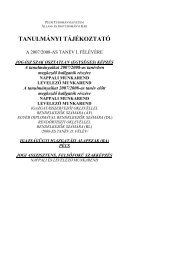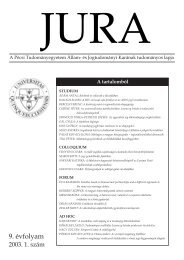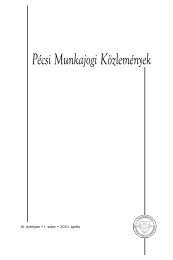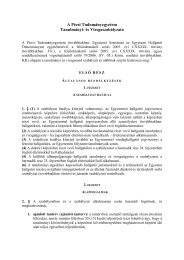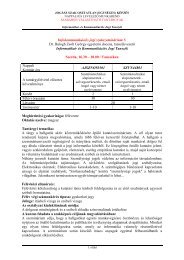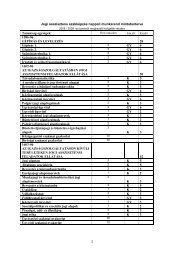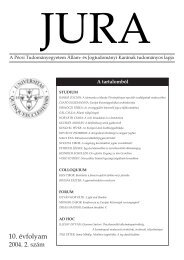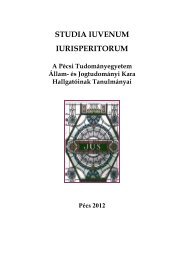2012. évi 2. szám - Jura - Pécsi Tudományegyetem
2012. évi 2. szám - Jura - Pécsi Tudományegyetem
2012. évi 2. szám - Jura - Pécsi Tudományegyetem
- TAGS
- jura
You also want an ePaper? Increase the reach of your titles
YUMPU automatically turns print PDFs into web optimized ePapers that Google loves.
138 Andityas Soares de Moura Costa Matos: An alternative approach to the basic norm …Due to its abstract feature and its controversialnature – juridical fiction, logical-transcendentalhypothesis, presupposition? – the basic norm wasnever well understood, except by a small circle ofjurists versed in the secrets of Kelsen’s normativism.Yet, and perhaps even unconsciously, the notion ofthe basic norm plays a central role in the practice oflaw. The purpose of this paper is to bring into lightthe paradigmatic aspect of the basic norm, as an essentialconcept for the legal conformation of the contemporaryState, but not before we review the maintheoretical elements necessary to understand legalnormativism, which is the school of legal thinking inwhich the theory of the basic norm arises (section 2).In section 3, we discuss the nature and functions ofthe basic norm, in order to finally conclude with analternative approach to the basic norm as a scientificpostulate.<strong>2.</strong> Legal normativismand the basic normNormativism is a nineteenth century legal positivistschool of thought. By being legal positivist, legalnormativism accepts two main assumptions, namely:a) to restrain itself to the study of the existing law,i.e., to the actually exiting law in social reality, whichbrings as a consequence the denial of the existence ofany metaphysical legal order, such as natural law; b)the assumption of an epistemological stance orientedtowards a non-evaluative point of view and the constructionof a rigorous scientific discourse, which isinfluenced by the Vienna Circle of Carnap, Neurathand Schlick. Legal normativism was initially developedby German scholars such as Edmund Bernatzik,Otto Mayer and Paul Laband, who started from thefundamental work of Carl Friedrich von Gerberand Georg Jellinek to try to establish a scientific andobjective view of law and the State. However, onlyafter the work of Hans Kelsen (1881-1973) it gainedtheoretical-philosophical density, becoming vividlydiscussed in academic circles. We can list some juristswho, in a greater or lesser degree, were normativists:Adolf Julius Merkl, Alfred Verdross, Felix Kauffmann,Felix Schreier, Franz Weyr and Josef Kunz,authors who, along with Kelsen, joined the VienneseSchool (Wiener Schule). Although not being properlynormativists, we can highlight the names of Alf Ross,Herbert Hart, Joseph Raz, Luis Legaz y Lacambra andNorberto Bobbio, who have adopted several pointsof Kelsen’s normativism.The basic principles of the legal normativism aregiven in the “Pure Theory of Law” (“Reine Rechtslehre”)by Kelsen, whose second – and final edition –was published in 1960. Earlier, in 1911, Kelsen hadalready laid the foundations of the legal normativismin the book “Main Problems in the Theory of PublicLaw” (“Hauptprobleme der Staatrechtslehre”), whichwould be followed by the first edition of “PureTheory of Law” in 1934 and “General Theory ofLaw and State” in 1945. By the time of publicationof the latter, Kelsen was living in the United Statesof America due his Jewish ancestry and Nazism wason the rise in Europe. It is also convenient to keep inmind the “General Theory of Norms” (“AllgemeineTheorie der Normen”), a posthumous work of 1979that should be carefully analyzed because it is a collectionof texts and articles written by Kelsen in verydifferent stages of his life.In his Pure Theory of Law, Kelsen is concernedwith the form of law, embracing the lessons of Aristotle,who believes that the only possible scienceis the universal one, because the particular escapesfrom the generalizing and synthesizing capacity inherentto human knowledge. Regarding to the legalexperience, only the form is shown to be universal,since its content is infinitely variable depends oncertain historical, political, economic, ideologicalconditions. Kelsen, therefore, holds that legal theoristsare obliged to devise a valid, formal and emptyfundament to law– as we shall see in section 3.2 – inorder to contrast it with the indeterminacy and particularityof their own moral and political criteriaunder which good part of the legal theories of thetime were conceived (Honoré 2007, 95).We can’t accuse Kelsen of being unclear as to theintentions that inform his theoretical approach. Inthe very first line of the first page of the definitiveedition of the “Pure Theory of Law”, he states: “ThePure Theory of Law is a theory of positive law – ofpositive law in general, not of a particular legal order.It is a general theory of law, not an interpretationof specific national or international legal norms”(Kelsen 1997, 1). These words, as one can easily notice,are very similar to those 1 of John Austin whenhe summarizes the scope of his famous work “Theprovince of jurisprudence determined”.The gravitational centre of Kelsen’s universalisticproject is rooted in the concept of a legal norm; anobjective “ought” by which we characterize law asa system of sanctions – e.g., social morality, religion– thanks to the possibility of bringing all the systemelements to an unifying instance called basic norm(Grundnorm) (Goyard-Fabre 1986, 34; Kelsen 2007a,13). The legal norms are commandments directedat the human conduct which allow, prohibit, commandand define competences, presenting sociallyorganized and immanent sanctions, in this precisepoint they are different from, respectively, socialJURA 2012/<strong>2.</strong>



